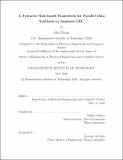| dc.contributor.advisor | Takako Aikawa. | en_US |
| dc.contributor.author | Kimn, Alex(Alex H.) | en_US |
| dc.contributor.other | Massachusetts Institute of Technology. Department of Electrical Engineering and Computer Science. | en_US |
| dc.date.accessioned | 2020-09-15T21:56:44Z | |
| dc.date.available | 2020-09-15T21:56:44Z | |
| dc.date.copyright | 2020 | en_US |
| dc.date.issued | 2020 | en_US |
| dc.identifier.uri | https://hdl.handle.net/1721.1/127416 | |
| dc.description | Thesis: M. Eng., Massachusetts Institute of Technology, Department of Electrical Engineering and Computer Science, May, 2020 | en_US |
| dc.description | Cataloged from the official PDF of thesis. | en_US |
| dc.description | Includes bibliographical references (pages 99-103). | en_US |
| dc.description.abstract | A lack of parallel training data is the greatest barrier to progress in developing models for grammatical error correction (GEC). This data scarcity issue is especially pronounced for Japanese GEC, where very few parallel error-correct corpora are publicly available. Thus, in this thesis, we propose a syntactic rule-based data synthesis framework designed to generate large parallel training corpora for Japanese GEC. This framework involves two components. The first is a set of syntactic rules that each characterize a common Japanese grammatical error and a corresponding correction by using syntactic information extracted from a small seed corpus. The second is a process for systematically generating error-correct sentence pairs by applying these syntactic rules to any arbitrary corpora of correct Japanese text. To test this framework, we train a standard neural machine translation (NMT) system for Japanese GEC on a training dataset that combines the publicly available Lang-8 corpus and our synthesized data. We evaluate this trained model on a novel parallel training corpus designed to mimic Japanese learners' writing in the classroom setting and compare it's performance to a similar model trained on the Lang-8 corpus alone. Using this comparison, we show that our synthesised data can significantly improve the performance of Japanese GEC systems. | en_US |
| dc.description.statementofresponsibility | by Alex Kimn. | en_US |
| dc.format.extent | 103 pages | en_US |
| dc.language.iso | eng | en_US |
| dc.publisher | Massachusetts Institute of Technology | en_US |
| dc.rights | MIT theses may be protected by copyright. Please reuse MIT thesis content according to the MIT Libraries Permissions Policy, which is available through the URL provided. | en_US |
| dc.rights.uri | http://dspace.mit.edu/handle/1721.1/7582 | en_US |
| dc.subject | Electrical Engineering and Computer Science. | en_US |
| dc.title | A syntactic rule-based framework for parallel data synthesis in Japanese GEC | en_US |
| dc.type | Thesis | en_US |
| dc.description.degree | M. Eng. | en_US |
| dc.contributor.department | Massachusetts Institute of Technology. Department of Electrical Engineering and Computer Science | en_US |
| dc.identifier.oclc | 1192561491 | en_US |
| dc.description.collection | M.Eng. Massachusetts Institute of Technology, Department of Electrical Engineering and Computer Science | en_US |
| dspace.imported | 2020-09-15T21:56:44Z | en_US |
| mit.thesis.degree | Master | en_US |
| mit.thesis.department | EECS | en_US |
